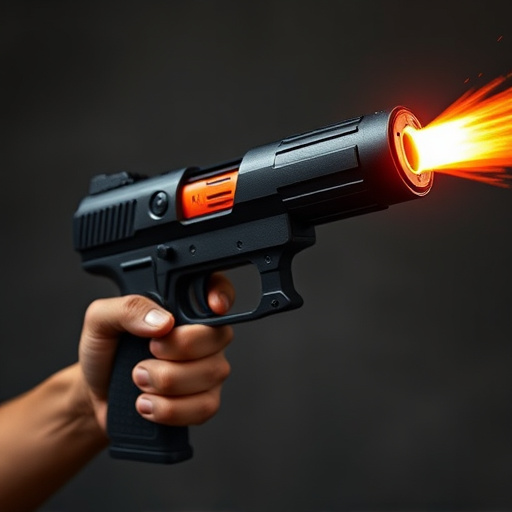Accidental discharge of powerful devices like the Master Blaster stun gun poses significant risks, including electric shock, burns, and impact damage due to user error or mechanical failures. To prevent severe injuries or fatalities, understanding these risks is crucial for implementing effective safety mechanisms. The Master Blaster Stun Gun features innovative safety locks and smart triggers, ensuring control and reliability in self-defense scenarios. Comprehensive training, regular maintenance, and adhering to guidelines are vital for minimizing risks. Advanced safety technologies, including motion sensors and machine learning, are transforming high-risk environments, with future developments aiming to incorporate biometric authorization for enhanced security.
Accidental discharge of firearms is a significant concern, leading to severe injuries and fatalities. This article explores comprehensive strategies to prevent such incidents, focusing on the innovative Master Blaster Stun Gun. We delve into the risks and causes of accidental discharges, analyze the unique features and design of the Master Blaster that prioritize safe handling, and discuss prevention protocols. Additionally, we examine advanced mechanisms and future considerations for enhancing safety in the context of stun guns.
- Understanding Accidental Discharge: Risks and Causes
- Master Blaster Stun Gun: Features and Design for Safe Handling
- Prevention Strategies: Protocols and Best Practices
- Enhancing Safety: Advanced Mechanisms and Future Considerations
Understanding Accidental Discharge: Risks and Causes
Accidental discharge, especially with powerful devices like a master blaster stun gun, poses significant risks and has various causes. These incidents can lead to severe injuries or even fatalities if not handled properly. The primary risks include electric shock, burns, and secondary damage from the device’s impact, which can vary greatly depending on its design and power output.
Common causes of accidental discharge range from user error, such as improper handling or failure to follow safety guidelines, to mechanical failures like malfunctioning triggers or faulty wiring. For stun guns, specific risks may arise due to their compact size and ease of carry, making them more prone to accidental activation during storage or transit. Understanding these risks and causes is crucial in implementing effective prevention mechanisms.
Master Blaster Stun Gun: Features and Design for Safe Handling
The Master Blaster Stun Gun stands out among personal defense devices with its innovative features and user-centric design, prioritizing both effectiveness and safe handling. This stun gun is engineered to deliver a powerful electric shock, incapacitated potential attackers instantly. Its compact size and ergonomic grip make it easily wieldable, allowing users to maintain control even in stressful situations.
The device incorporates advanced safety mechanisms to prevent accidental discharge, ensuring that only the intended target receives the jolt. A smart trigger system requires a firm press, minimizing the risk of unintentional activation. Additionally, the Master Blaster features a built-in safety lock, providing an extra layer of protection. This thoughtful design combines power and precaution, making it a reliable choice for those seeking self-defense solutions while emphasizing safe handling practices.
Prevention Strategies: Protocols and Best Practices
In the realm of self-defense tools like the Master Blaster stun gun, accidental discharge prevention is paramount to ensure safety and effectiveness. Protocols and best practices play a crucial role in minimizing risks associated with such devices. One primary strategy involves comprehensive training programs that educate users on proper handling techniques, including grip, activation procedures, and safe storage methods. Regular maintenance checks are also essential; this includes inspecting the device for any damage or wear and ensuring all safety mechanisms function optimally.
Additional measures include adhering to specific guidelines for trigger control, such as keeping fingers off the trigger until ready to deploy and maintaining a secure hold to prevent accidental presses. Secure storage solutions, like locked cases or safes, can further reduce the risk of unintentional activation. Moreover, staying informed about local laws and regulations regarding stun gun use is vital; compliance ensures not only legal adherence but also fosters public trust in responsible self-defense practices.
Enhancing Safety: Advanced Mechanisms and Future Considerations
In the pursuit of enhancing safety, especially in high-risk environments, advanced mechanisms play a pivotal role. Modern technologies like the master blaster stun gun introduce innovative accidental discharge prevention features. These devices employ sophisticated sensors and smart algorithms to ensure user safety while maximizing effectiveness. For instance, motion sensors and proximity detectors can automatically disable the weapon when no target is within range, significantly reducing the risk of unintentional activation.
Future considerations for accidental discharge prevention should focus on integrating machine learning capabilities to adapt to varying user needs and environments. Additionally, biometrics could be employed to authorize device use, ensuring only authorized personnel can operate such powerful tools. As technology advances, these safety mechanisms will become more sophisticated, making devices like the master blaster stun gun safer and more reliable for their intended purposes.
Accidental discharge of stun guns can be mitigated through a combination of education, proper handling protocols, and innovative technology. The Master Blaster Stun Gun, with its unique features and safe design, serves as a significant advancement in personal safety equipment. By understanding the risks and causes of accidental discharges, implementing best practices, and embracing future advancements like enhanced mechanical safeguards, users can maximize the benefits of stun guns while minimizing potential hazards. These strategies collectively contribute to a safer landscape for those relying on stun weapons for self-defense.
